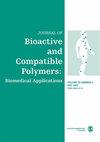Coating of silver nanoparticles on polyurethane film surface by green chemistry approach and investigation of antibacterial activity against S. epidermidis
IF 2.2
4区 生物学
Q3 BIOTECHNOLOGY & APPLIED MICROBIOLOGY
引用次数: 2
Abstract
Silver nanoparticles with potential antibacterial properties are included in biomaterials for the production of medical devices, which are used for diagnoses or treatment purposes. The aim of the current study was coating the polyurethane (PU) films with silver nanoparticles (AgNPs) due to their antibacterial efficacy. PU films were first modified by chitosan (CH), treated with AgNO3 to let CH chelate with silver ions, and then treated with vitamin-C (vit C) or glucose (Glu) to reduce the adsorbed ions to atomic silver to form AgNPs. The surfaces of the films were examined by ATR-FTIR, XPS, XRD, and SEM. Chemical bond formation between CH and Ag ions and AgNPs were determined by ATR-FTIR. Meanwhile, XPS and SEM analyses proved the presence of reduced metallic silver and nanoparticles on the film surfaces, respectively. According to the SEM analyses, a homogeneous distribution of AgNPs, with sizes 99–214 nm and 37–54 nm, on the film surfaces were obtained depending on Glu or vit C reduction, respectively. The films presented excellent antibacterial performance against Gram positive Staphylococcus epidermidis (S. epidermidis). These results suggested that the mentioned green technology can be easily applied to obtain AgNP coated polymeric surfaces with very high antibacterial efficacy. Although there are some studies dealing with AgNP formation on PU sponges or fibers, to the best of our knowledge, this is the first study showing AgNP formation on the CH conjugated PU films.绿色化学方法在聚氨酯膜表面涂覆纳米银及其对表皮葡萄球菌的抗菌活性研究
具有潜在抗菌特性的银纳米颗粒包括在用于诊断或治疗目的的医疗设备生产的生物材料中。由于银纳米粒子的抗菌效果,本研究的目的是在聚氨酯(PU)薄膜上涂覆银纳米粒子(AgNPs)。先用壳聚糖(CH)对PU膜进行改性,用AgNO3处理使CH与银离子螯合,再用维生素C (vit C)或葡萄糖(Glu)处理使吸附的离子还原为原子银形成AgNPs。采用ATR-FTIR、XPS、XRD和SEM对膜表面进行了表征。用ATR-FTIR测定了CH和Ag离子及AgNPs之间的化学键形成。同时,通过XPS和SEM分析,证实了薄膜表面分别存在还原性金属银和纳米粒子。SEM分析表明,经Glu还原和vit C还原的AgNPs在膜表面分布均匀,尺寸分别为99 ~ 214 nm和37 ~ 54 nm。该膜对革兰氏阳性表皮葡萄球菌(S. epidermidis)具有良好的抗菌性能。这些结果表明,上述绿色技术可以很容易地应用于获得具有很高抗菌效果的AgNP包被聚合物表面。虽然有一些研究涉及AgNP在PU海绵或纤维上的形成,但据我们所知,这是第一次研究显示AgNP在CH共轭PU膜上的形成。
本文章由计算机程序翻译,如有差异,请以英文原文为准。
求助全文
约1分钟内获得全文
求助全文
来源期刊

Journal of Bioactive and Compatible Polymers
工程技术-材料科学:生物材料
CiteScore
3.50
自引率
0.00%
发文量
27
审稿时长
2 months
期刊介绍:
The use and importance of biomedical polymers, especially in pharmacology, is growing rapidly. The Journal of Bioactive and Compatible Polymers is a fully peer-reviewed scholarly journal that provides biomedical polymer scientists and researchers with new information on important advances in this field. Examples of specific areas of interest to the journal include: polymeric drugs and drug design; polymeric functionalization and structures related to biological activity or compatibility; natural polymer modification to achieve specific biological activity or compatibility; enzyme modelling by polymers; membranes for biological use; liposome stabilization and cell modeling. This journal is a member of the Committee on Publication Ethics (COPE).
 求助内容:
求助内容: 应助结果提醒方式:
应助结果提醒方式:


